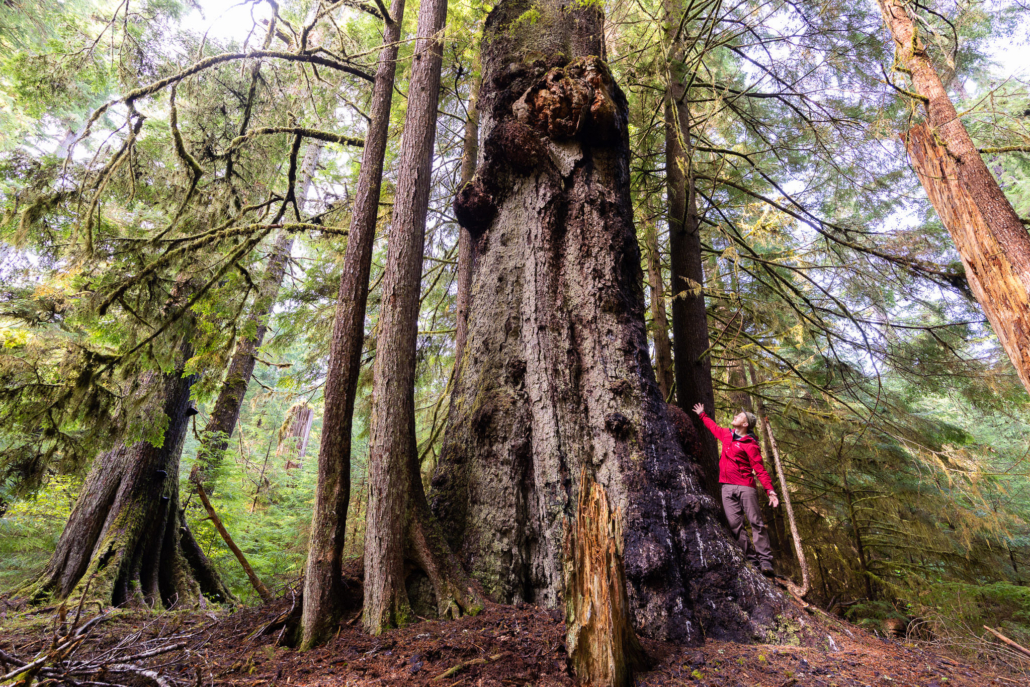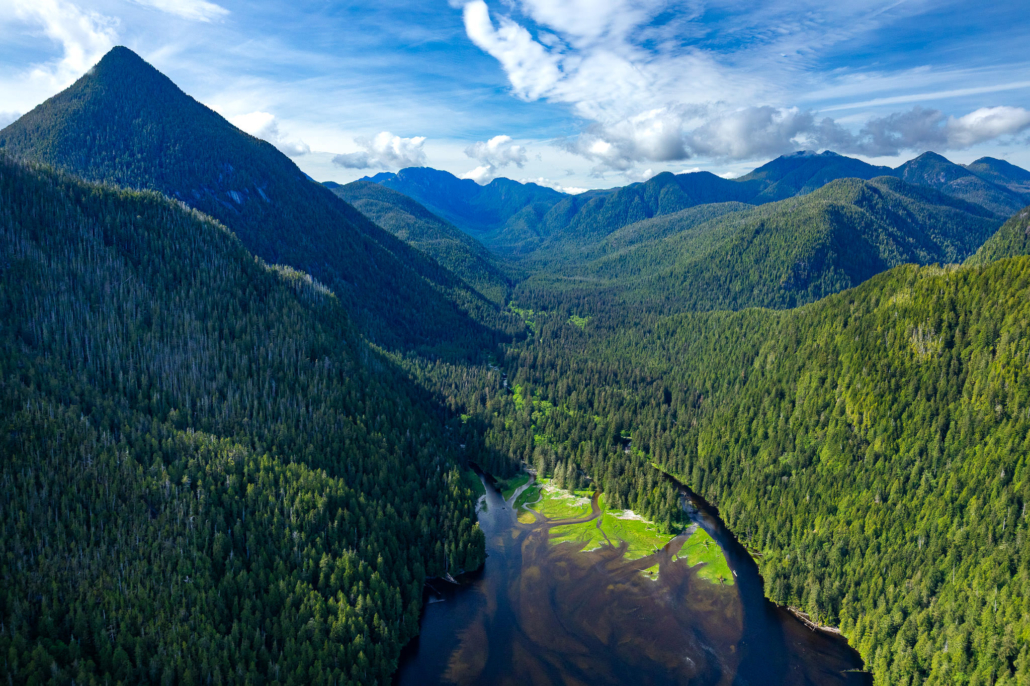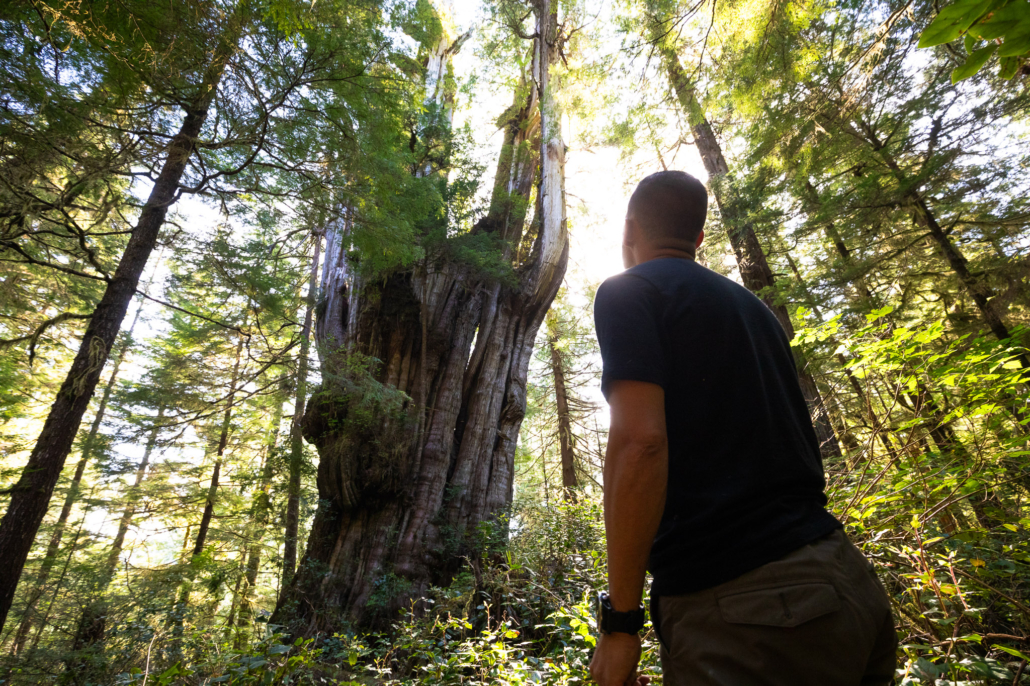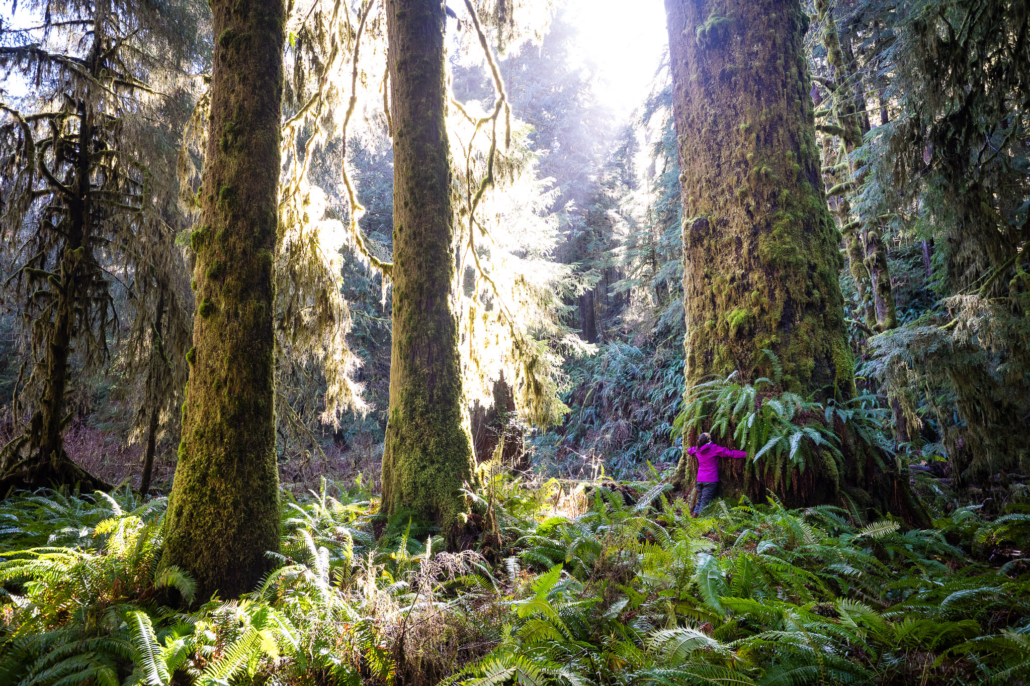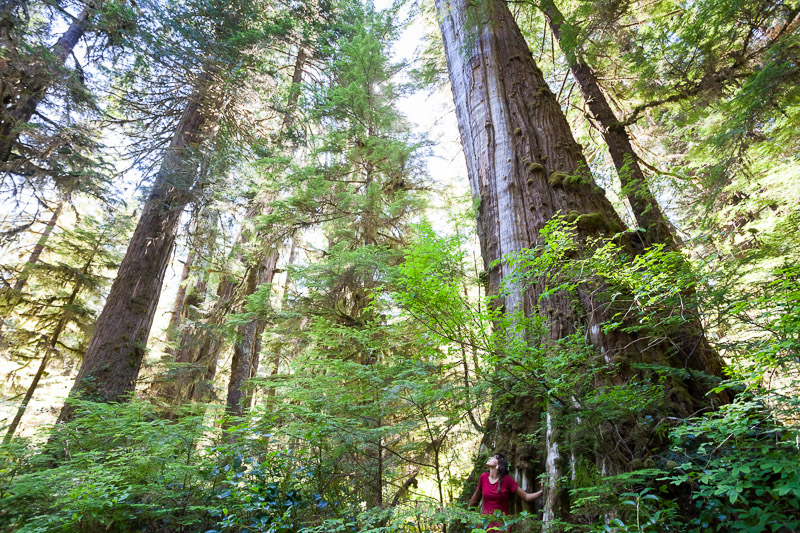 Jan 1 2018
Jan 1 2018Policy Recommendations for Old-Growth Forest Protection, support for First Nations, and Sustainable Forestry Jobs in BC
Policy Recommendations for Old-Growth Forest Protection, support for First Nations, and Sustainable Forestry Jobs in BC
Background
British Columbia's old-growth forests are an iconic part of the province’s identity and are home to the largest trees on Earth, surpassed only by the US redwoods in grandeur.
A century of industrialized logging has resulted in over 75 per cent of the original, productive old-growth forests being logged on BC’s southern coast, including well over 90 per cent of the valley bottoms where the richest biodiversity and largest trees are found.[1],[2] Continued old-growth logging threatens vulnerable plant and animal species, contributes heavily to the province’s carbon emissions,[3] degrades fresh water sources and wild fisheries, and is adversely impacting the economy, communities, and First Nations cultures, whose unceded lands these are.
For almost 50 years, the struggle to protect BC’s old-growth forests has led to some of the province’s most enduring conflicts. However, much has changed since the “War in the Woods” of the 1990s. The economic landscape has changed, resulting in a significant decline in forestry sector employment and an increase in the value of standing old-growth forests; vast areas of second-growth forests have reached maturity, constituting most of BC’s productive coastal forest lands; recognition of aboriginal rights has greatly expanded; the environmental movement and its values are more pervasive; environmental pressures such as climate change and biodiversity loss have compounded; and old-growth forests have become ever scarcer.
Employment levels in BC’s forestry sector have declined dramatically, from 99,000 jobs in 2000 to 65,000 in 2015, constituting a loss of one-third of all forestry jobs.[4] At the same time, the value of protecting old-growth forests now economically outweighs the economic benefits of logging them in large parts of the province, according to a 2008 study.[5]
In recent years, support for increased old-growth protection has broadened to include unions, chambers of commerce and municipalities. For example, the Union of BC Municipalities (UBCM), representing mayors, city and town councils, and regional districts across BC, and the Association of Vancouver Island and Coastal Communities (AVICC) have passed a resolution calling for an end to old-growth logging on Vancouver Island;the BC Chamber of Commerce, representing 36,000 BC businesses, has called for expanded old-growth forest protection in BC in order to benefit the economy; and two major forestry unions – the Private and Public Workers of Canada (PPWC) and Unifor, which represent thousands of BC forestry workers -have been working closely with environmental groups to upgrade environmental standards and forestry employment.
Developing a plan to protect the province’s old-growth forests while ensuring a sustainable, value-added second-growth forest industry will undoubtedly receive strong, widespread support. It is a first-rate opportunity for the NDP government.
Many BC First Nations communities have also taken action to protect old-growth in their territories and to develop conservation-based economies. For example, both the Ahousaht and Tla-o-qui-aht Nations in Clayoquot Sound have developed preliminary land use plans that place the majority of their territories off-limits to old-growth logging. In addition, First Nations communities in the province’s northern rainforests in Haida Gwaii and the Great Bear Rainforest have succeeded in achieving conservation financing support from the province, federal government, and environmental non-governmental organizations (ENGOs) to help develop sustainable economies in conjunction with implementing ecosystem-based management (EBM) guidelines for forestry.
BC NDP Government Commitments
In its 2017 election platform, the BC New Democratic Party promised to “apply an evidence-based scientific approach to land-use planning, using the ecosystem-based management of the Great Bear Rainforest as a model for managing…old-growth forests.” The NDP has also committed to finding “fair and lasting solutions that keep more logs in BC for processing”
and to partner with First Nations to “modernize land-use planning to effectively and sustainably manage BC’s…old-growth.” The 2017 Confidence and Supply Agreement between the BC Green and the BC NDP caucuses states that the government will “reinvigorate our forest sector to improve both environmental standards and jobs for local communities.”
The Ministerial Mandate for the Ministry of Forests, Lands, Natural Resource Operations and Rural Development (FLNRORD) from John Horgan on July 18th directs the new minister to “work with the Minister of Indigenous Relations, First Nations and communities to modernize land-use planning and sustainably manage B.C.’s ecosystems, rivers, lakes, watersheds, forests and old growth” and to “improve wildlife management and habitat conservation, and collaborate with stakeholders to develop long and short term strategies to manage B.C.'s wildlife resources.”
The following set of policy recommendations, compiled by a group of environmental organizations, is designed to help the new provincial government fulfill these commitments. They aim to protect BC’s endangered old-growth forests using science, while applying a system of incentives and regulations to support a vibrant forest industry, ensuring good paying jobs for working families through the sustainable harvesting and value-added manufacturing of second-growth stands.*
1) Seek a Dialogue with First Nations on how Old-Growth Protection can be Integrated into Indigenous-Led Land Use Planning, New Governance Models, and Economic Initiatives
Many of the province’s existing land use plans are out-dated and fail to align with the current political and legal authority of BC’s First Nations. However, only in a few parts of the province have indigenous land use plans been recognized and supported by provincial legislation and policies, notably in Haida Gwaii, Squamish and Lil’wat territory, and in the Great Bear Rainforest. The province should seek a dialogue with First Nations on how old-growth can be integrated into their land use plans, governance models, and economic initiatives. It should support the development of and formally recognize First Nations land use plans, Tribal Parks, and protected areas.
2) Develop an Old-Growth Forest Protection Act
The BC Government should develop a science-based, legislated plan that includes targets and timelines for protecting old-growth forests in all forest types based on best available science, including stronger protection for cultural old-growth values (such as Culturally Modified Trees); halts or quickly phases out logging of old-growth depending on their degree of endangerment; and establishes an extensive system of old-growth reserves that are selected using science-based criteria. [6] Read an example of an Old-Growth Forest Protection Act here.
3) Appoint an Independent Science Panel
An Old-Growth Forest Protection Act would require the BC government appoint an independent science panel, responsible for guiding the implementation of the Act and developing a framework for old-growth forest protection across the province. This would involve mapping BC’s old-growth forests by forest type and productivity level, determining how much old-growth must remain in each forest type to maintain ecological integrity, determining the current status of each forest type, and recommending minimum old-growth protection targets.
4) Support Conservation Financing Solutions and Economic Diversification for First Nations Communities
Many First Nations communities make significant revenues from old-growth logging, yet lack a range of alternative economic development opportunities that would support their local economies into the future and allow them to transition away from old-growth logging, should they wish to. In order to protect old-growth forests on a large scale in BC, the provincial government should fund conservation financing solutions to support First Nations sustainable economic development as an alternative to old-growth logging, similar to the $120 million (including $30 million in provincial funds) provided to nations in the Great Bear Rainforest in support of ecosystem-based management in that region. This is a fundamentally important precursor for the large-scale protection of old-growth forests in BC and for the NDP government to effectively implement its commitment to applying ecosystem-based management (EBM) to old-growth forests across BC.
5) Support a Sustainable, Value-Added Second-Growth Forest Industry
While most of the Western industrialized world is logging 50- to 100-year-old stands, including second-, third-, and fourth-growth forests, the status quo of old-growth liquidation is still underway across much of BC. By strengthening forest practices regulations and reducing the excessive rate of cut (i.e. implementing longer rotation ages), BC can achieve sustainable, second-growth forest industry. At the same time, if the BC government were to promote policies that support greater processing and value-added manufacturing of second-growth logs in the province, the total number of forestry jobs could be sustained and even increased in the province while old-growth logging is quickly phased out.
The following policies are recommended to support value-added, second-growth forestry jobs:
- Implement regulations or tax incentives to retool old-growth mills to process second-growth logs and to develop new second-growth mills and value-added facilities (for example, by forgoing the PST on new mill equipment and reducing stumpage fees or property taxes for companies which invest in second-growth mills).
- Use stumpage fees to expand markets for sustainable, value-added, eco-certified, second-growth forest products in various international jurisdictions, while discontinuing the marketing of old-growth and raw logs.
- Ensure a significant portion of BC logs harvested by tenure holders is sold through regional log sorts that make wood available to smaller mills and value-added manufacturers.
- Curb raw log exports by banning old-growth log exports and increasing the fee-in-lieu (i.e. log exports tax) on second-growth log exports to curb their export and encourage domestic processing.
- Diversify tenures to include more Community Forests and First Nations tenures in order to create local jobs and facilitate the expansion of a value-added forest industry.
6) Immediately Declare a Moratorium for Old-Growth Hotspot Sites to Create a Solution Space while Long-Term Solutions are Developed
Some old-growth forests are considered to be greater conservation priorities than others. These include stands that are more extensive and intact, have high cultural significance for First Nations, consist of rare forest types, are of high significance for wildlife and species at risk, are located in drinking watersheds of local communities, are particularly grand, and are of particular importance for recreation and tourism. It is recommended the BC government declare a moratorium for old-growth hotspot sites, thereby creating a solution space to determine the future regarding the possibility of long-term protection through legislated provincial conservancies or parks.
7) Expand the Existing Forest Reserve Network
The NDP government introduced a system of forest reserves in the 1990s, including Old-Growth Management Areas (OGMAs), Wildlife Habitat Areas (WHAs), Ungulate Winter Ranges, Visual Quality Objectives, Riparian Management Zones, and Recreation Areas. This reserve system has not been fully implemented, leaving vast areas of old-growth forest vulnerable to logging. The new government should fully implement the forest reserve system by converting all non-legal reserves into legally binding ones and expand the system to protect additional endangered old-growth forests. This can be done by quickly implementing the Big Tree Protection legal tool currently under development by the Ministry of FLNRORD and enhancing it to include the province’s grandest groves. In time, thesereserves would be replaced by a new system of forest protection under an Old-Growth Protection Act – the implementation of which will take some time. It is further recommended the government remove the existing 1 per cent cap on how much forest reserves may affect the timber supply.
8) Use Government Control Over BC Timber Sales’ Planning and Operations to Accelerate Conservation of Endangered Old-Growth Forests
BC Timber Sales (BCTS), a division of FLNRORD, is the BC government’s logging agency that plans and directly issues logging permits for about 20 per cent of the province’s merchantable timber on Crown lands, which fall outside of forestry tenures. As the BC government retains full control over which cut blocks are auctioned each year through BCTS, the incoming government should use this control to quickly phase out issuing timber sales in old-growth forests in these areas.
9) Phase out Old-Growth Logging in the Allowable Annual Cut
Currently, the government’s Timber Supply Branch fails to distinguish between old-growth and second-growth harvest levels in the Allowable Annual Cut (AAC) of each timber supply area (TSA) and tree farm licence (TFL). In order to more effectively manage the rate of old-growth logging, the BC government should apportion the Allowable Annual Cut so it distinguishes between old-growth and second-growth cut allocations in order to scale-down and phase out old-growth cutting, according to the conservation needs identified by the independent science panel.
10) Establish a Land Acquisition Fund to Protect Endangered Ecosystems on Private Lands.
Many of BC’s most endangered and biologically rich and diverse ecosystems, including many old-growth stands, are found on private lands, which constitute about 5 per cent of the province’s land base. Establishing new protected areas on private land requires the outright purchase of lands from willing sellers. To this end, the B.C. government should implement a minimum annual $40 million provincial Natural Lands Acquisition Fund, which could increase by $10 million/year until the fund reaches $100 million/year. The proposed fund would enable the timely purchase of significant tracts of endangered private lands of high conservation, scenic, and recreation value to add to BC’s parks and protected areas system and resolve countless land use battles in the province.
*These recommendations would exclude the Great Bear Rainforest and Haida Gwaii, where science-based old-growth protection plans already exist and have resulted in high levels of old-growth forest protection.
[1] Ancient Forest Alliance, Maps: Remaining Old-Growth Forests on BC’s Southern Coast: https://staging.ancientforestalliance.org/ancient-forests/before-after-old-growth-maps/
[2] Sierra Club BC backgrounder, March 2016: https://sierraclub.bc.ca/wp-content/uploads/2015/08/South-Coast-Backgrounder_March-2016.pdf
[3] Sierra Club BC, BC Forests Carbon Meltdown, January 2014, https://sierraclub.bc.ca/wp-content/uploads/2015/08/forest-backgrounder_draft.pdf
[4] Statistics Canada, https://cfs.nrcan.gc.ca/statsprofile/employment/bc
[5] Knowler, D., 2008, The Economics of Protecting Old Growth Forest: An Analysis of Spotted Owl Habitat in the Fraser Timber Supply Area of British Columbia https://www.davidsuzuki.org/publications/downloads/2008/SPOWL_Final_report.pdf
[6] 2013 report by UVic Environmental Law Centre and Ancient Forest Alliance https://www.elc.uvic.ca/press/documents/AnOldGrowthProtectionActforBC-2013Apr10.pdf

